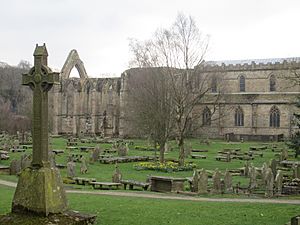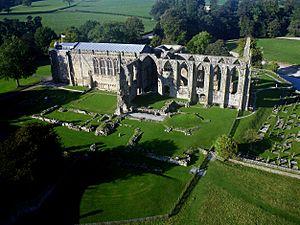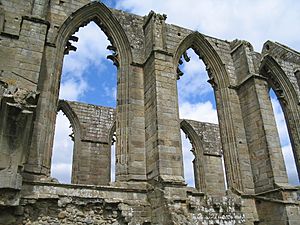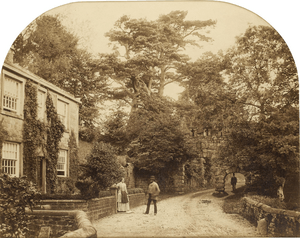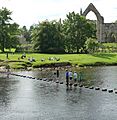Bolton Abbey facts for kids
Bolton Abbey is a famous place in Wharfedale, North Yorkshire, England. It gets its name from the old ruins of a 12th-century monastery called Bolton Priory. This priory was a type of monastery, run by Augustinians. King Henry VIII ordered it to close in 1539 during the Dissolution of the monasteries. The priory is located in the beautiful Yorkshire Dales, right next to the village of Bolton Abbey.
The Bolton Abbey estate is open for people to visit. It has many miles of paths for walking, no matter the weather. You can also take a fun ride on the Embsay & Bolton Abbey Steam Railway. This train stops at Bolton Abbey station, which is about 2.5 km (1.5 miles) from the Priory.
Contents
Bolton Priory: A Look Back in Time
The monastery was first started in a place called Embsay in 1120. Even though it's called Bolton Abbey, it was actually a priory because it was led by a prior. The Augustinian order officially founded it in 1154. It was built right by the River Wharfe. Lady Alice de Romille of Skipton Castle gave the land and other things to the Augustinians in 1154.
In the early 1300s, Scottish raiders attacked the priory. This caused a lot of damage, and the monks had to leave for a while. The priory's special seal showed the Blessed Virgin Mary and the Child. It had the words sigillum sancte Marie de Bolton on it.
The main part of the priory church, called the nave, started being used as a parish church around 1170. Because of this, it survived when King Henry VIII closed down the monasteries.
Building work was still happening at the priory when it was closed in January 1540. The eastern part of the church remains in ruins today. A tall tower, which was started in 1520, was left unfinished. Its bottom part was later turned into an entrance porch with a small bell. Most of the church that remains is in the Gothic style. More work was done on it during the Victorian era, including new windows designed by August Pugin. The church is still used for services today, especially on Sundays and holidays.
The churchyard at Bolton Abbey has a special grave for a Royal Flying Corps officer. He died during the First World War.
Exploring the Bolton Abbey Estate
The Domesday Book is a very old record from 1086. It shows that Bolton Abbey was once the main part of a huge estate. This estate included many areas like Halton East, Embsay, Draughton, and Skipton. After a rebellion, these lands were given to Robert de Romille around 1090. He moved the main office to Skipton Castle. Later, the estates passed to the Clifford family.
In 1748, Baroness Clifford married William Cavendish. This meant the Bolton Abbey Estate then belonged to the Dukes of Devonshire. Today, a special trust manages the estate.
The estate is very large, covering about 134 km2 (33,000 acres). It has six areas that are protected as Sites of Special Scientific Interest. One of these is Strid Wood, an old forest with many oak trees. This wood is home to a part of the River Wharfe known as The Strid. There's also a quarry where you can find old sea fossils!
The estate includes 13 km (8 miles) of river and many farms. It has 84 buildings that are important for their architecture. Four of these are Grade I listed, meaning they are very special. Many businesses, like tearooms and bookshops, are also on the estate. You can see the famous stepping stones that cross the River Wharfe near the Abbey ruins. The estate also has large areas for grouse and pheasant hunting. About 120 people work to keep the estate well-maintained.
Most of the estate is open to the public. You usually pay a fee for car parking. The Dales Way walking path goes through the estate. Parts of the moors, like Barden Moor and Barden Fell (which includes Simon's Seat), are open for people to explore. Sometimes, these areas might be closed during hunting season.
Bolton Abbey Hall was once the gatehouse of the priory. The Cavendish family later turned it into a house. It is a Grade II* listed building, which means it's also very important.
The Cavendish family also owns other famous estates. These include Chatsworth House in Derbyshire, England, and Lismore Castle in the Republic of Ireland.
In the early 1800s, a very large cow called the Craven Heifer was raised on the Bolton Abbey estate. She weighed about 1.98 tonnes (312 stone) and was over 3.45 meters (11 ft 4ins) long and over 2.1 meters (7 ft) tall! She is still known as Britain's largest cow ever.
The Priory Church Today
The Priory Church of St. Mary and St. Cuthbert at Bolton Abbey is an active Church of England church. It serves the village and parish of Bolton Abbey. It has many church services throughout the year, and a full-time rector lives nearby. This church is the part of the 12th-century Augustinian priory that is still standing and used today. It is located within the beautiful Yorkshire Dales National Park and the Bolton Abbey estate.
Bolton Abbey in Art and Stories
The ruins of Bolton Priory are very inspiring. They have been featured in many famous artworks and poems.
- Artist Edwin Landseer painted the Abbey.
- J. M. W. Turner created beautiful watercolours of it. One of his paintings, Bolton Abbey, Yorkshire (1809), is at the British Museum.
- The famous Brontë sisters (who wrote books like Jane Eyre) are thought to have visited the estate in 1833.
- William Wordsworth's poem The White Doe of Rylstone was inspired by his visit to Bolton Abbey in 1807.
- In Anthony Trollope's book Lady Anna (1874), a dramatic event happens by the river near the Abbey.
- Bolton Abbey was visited in episode 6 of the BBC series The Trip.
- A blurred photo of the Abbey is on the cover of the 1981 album Faith by the band The Cure.
- The music video for the 1985 song "If There's A Heaven Above" by Love and Rockets was filmed here.
- The BBC Television series Gunpowder (2017) used Bolton Abbey as a filming location.
Images for kids
See also
 In Spanish: Abadía de Bolton para niños
In Spanish: Abadía de Bolton para niños


